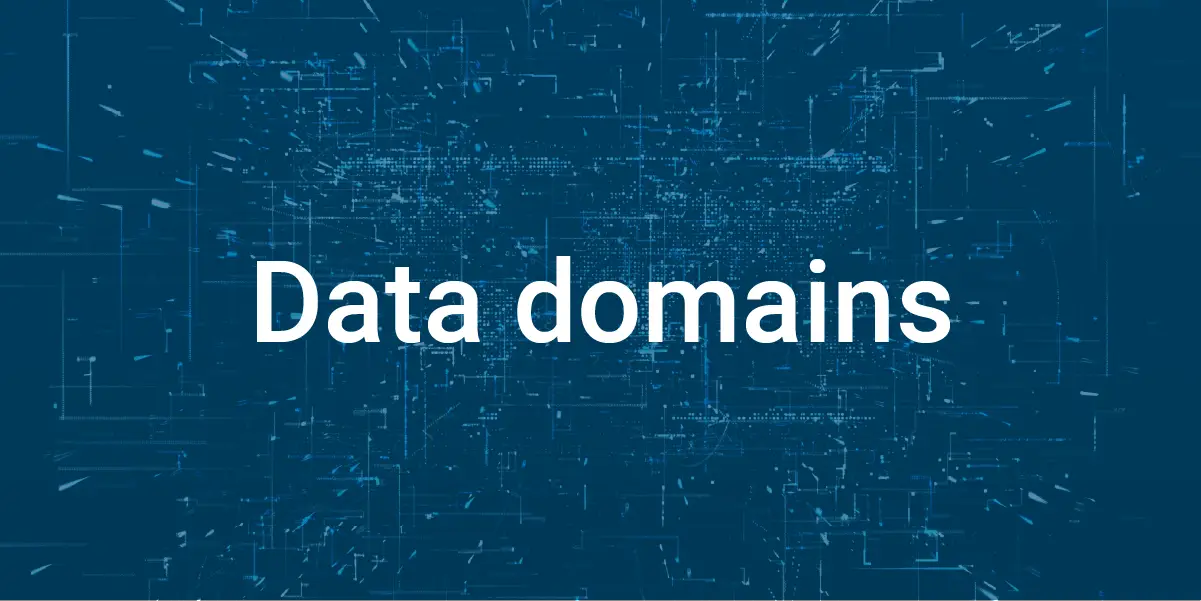Many modern organizations are buried in the weeds of complex data landscapes, and managing data domains well has become more vital than ever.
Data domains are fundamental for effective data management within any organization as they encompass key areas in the business.
In this article, we’ll dig into their significance, business use cases, and some best practices for establishing and maintaining them.
Mastering Data Domains: Table of Contents
What is a Data Domain: Definition and Examples
A master data domain structures data at a high level for business operations and governance.
Each domain is home to specific entities and attributes that are crucial to operations, making it easy to retrieve information when needed.
Data domains also pave the way for data governance. They allocate accountability and responsibility for data management and ensure accurate data handling and adherence to standards.
Logically grouping data elements can be based on a common purpose or business function, such as customer management, product tracking, or financial accounting.
To illustrate, some of the typical data domains found in various industries are as follows:
- Customer: Customer information, such as contact details, demographics, interests, and purchasing history.
- Product: Information on an organization’s products or services, such as descriptions, pricing, and technical details.
- Supplier: Suppliers or vendors’ information, including contact details, and contract terms.
- Location: Geographic information, such as coordinates, addresses, and regional boundaries.
- Employee: Employee-related data, such as job titles, roles and responsibilities, compensation package, and performance reviews.
- Finance: Financial data, including payment records, general ledger, and budget information.
Data domains are foundational categories within Master Data Management (MDM) responsible for managing and controlling data entities across organizations.
Are you interested in learning more about MDM?
Download our free ebook or watch the short video here to learn more.
5 Key Benefits: The Business Value of Mastering Data Domains
Data domains improve business outcomes by giving organizations a bird’s eye view of every aspect of their operations. These are some examples of business use cases that come with mastering them:1. Improve the Customer Experience
83% of executives believe unimproved CX poses a moderate to severe threat to revenue and market share. Mastering data domains can help them understand their customers and products better, which positively impacts the customer journey. For example, knowing a customer’s purchase history and preferences enables quicker, more tailored service and support. Moreover, 80% of customers find getting personalized experience as valuable as product or service quality, and companies that excel at it earn 40% more revenue from related activities than average players. Personalization also extends to marketing. With sufficient information on customer shopping habits, businesses can create personalized campaigns that cater to specific customer segments.2. Decrease Sourcing Costs
Organizations can improve their sourcing strategies by managing supplier, product, and location data domains better. Supplier and product information makes it easier to find the most cost-effective vendors and streamline the procurement process. One way it can help reduce sourcing costs is by identifying suppliers in specific regions that offer the best prices. Such simple shifts can make a big difference. Research shows that just a 10% reduction in supplier costs can boost EBITDA by up to 32%.3. Reduce Days Sales Outstanding (DSO)
Accurate and comprehensive data (especially regarding products and customers) are crucial for ensuring timely and correct order fulfillment. This information can directly impact the Days Sales Outstanding (DSO). Mastering these data domains can help businesses, particularly retailers, manufacturers, and distributors, ensure that the right products are delivered to the right customers promptly. This prompt service can lead to punctual payments, which can enhance financial stability and cash flow.4. Track Employee Benefits and Access
When organizations master employee data domains, they can allocate benefits accurately and manage access effectively. This is great news since 92% of surveyed employees find receiving adequate pay and benefits is linked to job satisfaction. More than that, organizations can improve security if they know who has access to sensitive information.5. Forecasting and Budget Allocation
Forecasting and budgeting are both dependent on accurate and well-managed finance and location data. Mastering these domains enables employees to make informed decisions about future financial planning and resource allocation. It assists in understanding the hierarchy of business units within an organization. As a result, businesses can better allocate budgets and predict future financial outcomes with greater accuracy by having detailed financial histories and understanding regional performance.How to Manage Data Domains Effectively
To define data domains, organizations need to develop a clear and comprehensive data taxonomy that reflects the organization’s goals and framework. Stakeholders are more likely to understand data classification when the classification is consistent.
Establishing clear ownership is crucial to managing data domains. Each domain should have its owner who oversees maintenance, governance, and quality assurance. Continuous monitoring ensures accountability.
Data domains also rely on data quality. Therefore, organizations need to implement standards and carry out regular audits (such as data validation and cleaning) to weed out poor data.
Aside from data quality, data domains need to meet security and compliance standards. Compliance with regulatory requirements and implementation of robust security measures, including access controls, encryption, and regular monitoring.
Lastly, companies need to understand the value of investing in advanced data integration solutions that will prevent data silos and connect information from diverse sources.
By applying these practices, it’s easier to optimize data management and ensure high-quality, safe, and compliant data domains.
Master Data Domains, Master Data Management
Organizations looking to improve operational efficiencies and boost financial performance must first understand each domain’s key pain points. By addressing these, they can see how the company’s bottom line can grow.
Need help establishing and maintaining data domains? We can help. Book a consultation call with Infoverity and optimize your enterprise data management today.



